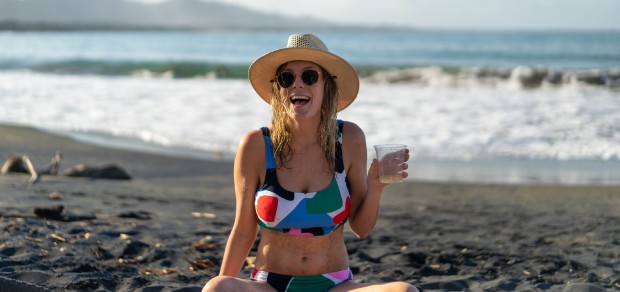
Rules for Spending Time in the Sun When You Have Psoriasis
When it comes to spending time in the sun, people typically hear one message loud and clear from doctors: Avoid direct sun exposure without adequate protection. To prevent deadly skin cancer, medical experts urge limiting time in the sun and the use of sunscreen and protective clothing, especially between the hours of 10 a.m. and 4 p.m., when sun rays are the strongest.
But some people find that spending a bit of time in the sun helps their psoriasis symptoms.
“Natural sunlight is composed of both UVA and UVB rays,” says Nina K. Antonov, M.D., a board-certified dermatologist at Modern Dermatology in Westport, Connecticut. “The UVB rays are what may benefit psoriasis symptoms, as these rays are more destructive to the superficial skin-cell layers, slowing the overgrowth of skin cells associated with psoriasis.”
But the destructive properties of those types of UV (ultraviolet) light may also cause problems if you overdo it. We talked to dermatologists to find out what type of sun exposure is helpful for psoriasis and how to catch a few rays safely, if you find that sunlight works for you.
The Safest Way to Get UV Exposure: Phototherapy
Studies have shown that sun exposure can, in fact, improve psoriasis. UV exposure has been shown to perpetuate rapid immunological changes in the skin and blood that can both clear current psoriasis plaques and reduce future flare-ups. In essence, this exposure may put some people in remission for weeks to months at a time.
Recognizing this, many dermatologists prescribe UV phototherapy to treat psoriasis and other inflammatory skin conditions such as eczema, pruritus (itch), cutaneous T-cell lymphoma, mycosis fungoides, and more.
“Phototherapy has been used for many skin diseases for hundreds of years,” says Karan Lal, D.O., a board-certified dermatologist at UMass Memorial Medical Center and marketing committee chair for the Society for Pediatric Dermatology.
“In dermatology offices, we offer phototherapy where we use specific wavelengths of UV light—narrowband UVB (311-312 nm) and UVA (320-400 nm)—to treat skin diseases,” says Lal. “Most often, for psoriasis, we use narrowband UVB, which is a specific wavelength of UVB, and this has not been shown to increase risk of skin cancer.”
Getting Sun Can Help, But Proceed with Caution
Getting phototherapy in a doctor’s office is considered safe, but that doesn’t mean you have the green light to ditch the sunscreen and endlessly bask on the beach.
Not even close. Sunlight exposure isn’t right for everyone with psoriasis, and some psoriasis treatments increase the risk of sunburn. (The systemic medication acitretin is one example of a treatment that ups sunburn risk.) If sunlight exposure is recommended, doctors say it’s with strict limitations.
Antonov is very cautious when it comes to sun-exposure recommendations, even for those with psoriasis.
“I advise the use of broad-spectrum sunscreen SPF 30 or higher for any and all sun exposure,” Antonov says. “Natural sunlight exposes you to the associated risk of skin cancer that accompanies any potential benefit to psoriasis symptoms.” It’s important to know that some people with psoriasis may be at higher risk of skin cancers from certain medications already. So it’s important to limit any additional risks, if possible.
Antonov says she specifically recommends physical sunscreens that are mineral-based because they’re less likely to irritate sensitive skin. These sunscreens have active ingredients such as zinc oxide and titanium dioxide.
Lal says that, in some cases, he tells patients they can get just 10 to 15 minutes of sunlight without sunscreen to the areas affected by psoriasis. After that, it’s right back to applying sunscreen and/or wearing sun protective clothing to prevent burning. Remember: Sunburns aren’t just painful; they can also cause psoriasis to flare. New psoriasis plaques tend to develop in areas of skin injury in what’s called the Koebner phenomenon.
Skip Tanning Beds Completely
It’s a hard no to tanning beds across the board from doctors. One may think, ‘If a little sun is okay, then a little tanning bed might not be so bad.’ However, experts say that’s not the case.
“Tanning beds mostly have UVA at very high doses, which penetrate deep into the skin,” Lal says. “UVA is carcinogenic, meaning enough exposure can lead to skin cancer.”
In the past, UVA was commonly used to treat psoriasis, vitiligo, and other inflammatory skin conditions, sometimes in combination with medications called psoralens. However, due to the higher rates of skin cancer associated with UVA therapy, this fell out of favor. Now, it’s rarely used—only in very severe cases, when patients have tried and failed with all other therapies, or in severe palmoplantar psoriasis, since it’s in a limited area of the body.
When asked if there’s ever a time when you can justify spending time in a tanning bed, Antonov issued an emphatic, “Never!” Even just one indoor tanning session can increase the risk of developing different types of skin cancer—melanoma by 20 percent, squamous cell carcinoma by 67 percent, and basal cell carcinoma by 29 percent, according to the American Academy of Dermatology.)
“Treatment with in-office light therapy is a safer alternative and is most successful when administered for a set time on a regular schedule,” Antonov says. Some insurance companies may approve people with psoriasis to have phototherapy units at home, which can be especially convenient for those who live far away from a dermatology office. To determine if phototherapy or natural sunlight exposure might help improve your psoriasis, talk to a board-certified dermatologist.
You May Also Like:
Want to Read More?
Access all of Twill Care’s content, community, and experts for free!
Already a member? Login
Want to Read More?
Access all of Twill Care’s content, community, and experts for free!
sign UP For FreeAlready a member? Login

